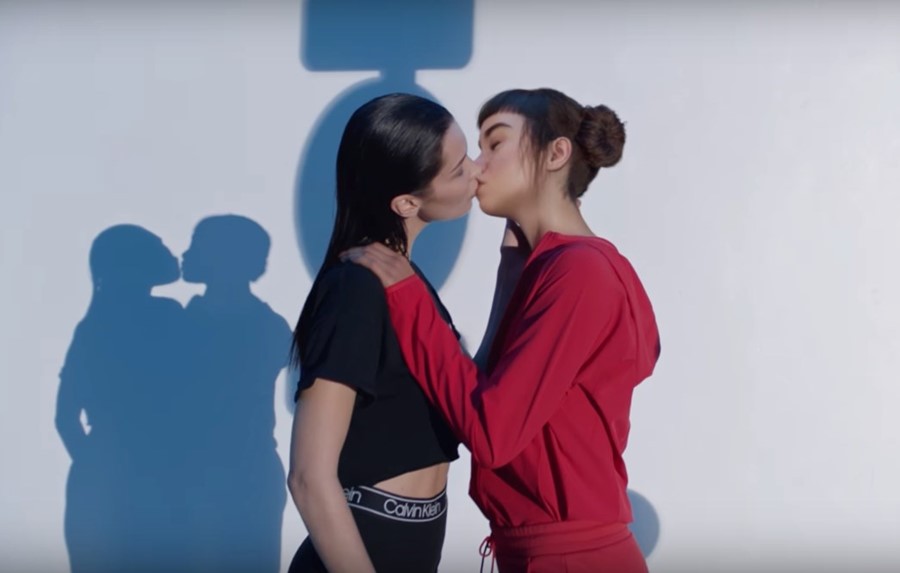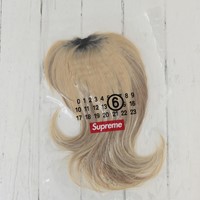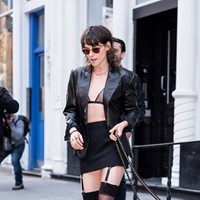Listen, all I want is to see actual queer human women kiss
The other day, curled up on the sofa watching First Dates with a girl so beautiful it sometimes feels hazardous to look directly at her, an advert came on. It wasn’t super exciting, something for a new car, but what marked it from the rest was the fact it featured a gay male couple, who, at the advert’s climax, kissed. “I don’t think I’ve ever seen a gay couple kiss in a TV advert before,” I said. She agreed, and I wondered how long it would be before we saw women do the same.
Turns out, not very long at all. Well, kind of. Yesterday afternoon, Calvin Klein released a thirty-second video onto its YouTube channel that features Bella Hadid in a ‘Calvin’ branded tee and biker shorts kissing digitally rendered, CK tracksuit-clad influencer Lil Miquela. “Life is about opening doors,” Hadid’s voiceover says, as Miquela enters the frame. “Creating new dreams you never knew could exist.” They kiss (very statically, zero tongue action) and pull away. End scene. “Bella Hadid and Lil Miquela Get Surreal”, the video’s title reads.
To insert some perhaps necessary context: Bella Hadid is one of the most famous models going. She is, as far as I know, or has been announced publicly, straight, with an on-again, off-again relationship with The Weeknd. Lil Miquela is a digital avatar who, in what is perhaps the best example of how we are all playing a character on social media, is a successful Instagram influencer. She has worked with brands like Prada and Nike, is a contributing editor to our sister site Dazed Beauty, and previously dated fellow digital model Blawko, which might make her queer or bisexual, if she, you know, actually existed – the ‘teenager’ is at least partly the Pygmalian-like creation of a male inventor.
With its “surreal” title and “Is this a dream or real?” captioning, Bella and Lil Miquela’s CK-branded make out sesh is presented as a fantasy. When it comes to representations of lesbianism, this is not new. From deeply unconvincing porn clearly catered towards men (the fake nails are a great giveaway); to Britney, Madonna, and Christina Aguilera at the VMAs, and even t.A.T.u, pop culture has a history of painting lesbianism as such a fantasy – as performative, something you can try on temporarily and use to titillate a voyeuristic (typically male) audience. Fashion, too, has long done the same – just take Helmut Newton’s sapphic Saint Laurent images or about a million Vogue Italia editorials. All of these visuals are representations of lesbianism rather than images created by or featuring women-attracted-women, aimed not so much at us but at a viewer who finds the idea of what we get up to behind closed doors sexually exciting.
In my opinion, CK’s ad borrows sexuality for clickbait, othering queerness as “surreal” (and combining it with the added virtual human gimmick) as engagement-driving content. (“The 22-year-old little sister of Gigi Hadid flashed her taut midriff in skintight athletic gear from the iconic American fashion brand,” purred hellhole gossip site Mail Online.) Two cis white actors snogging to sell a hatchback isn’t exactly the queer future I want, but their kiss felt notable because it was just part of the advert. It wasn’t a moment made out to look extreme or transgressive. It was normal. Bella and Miquela, on the other hand, is the opposite: it makes a spectacle of lesbian sexuality, inauthentically using the image of it to appear progressive and sell a product without actually representing the community. Despite the fact that CK underwear (albeit not to the same extent as Carhartt overalls or Dr Martens) are pretty lesbian if you’re anything masc of centre, this ad, by male director Jonas Lindstroem, is so clearly not marketed towards WLW.
“Pop culture has a history of painting lesbianism as such a fantasy – as performative, something you can try on temporarily and use to titillate a voyeuristic (typically male) audience”
It feels necessary to note that Calvin Klein – who sold the company that bears his name way back in 2002, always created sexually evocative ads. He is one of fashion’s most notable, and open, bisexuals, and this permeates much of the work he did; in other words, he was able to convincingly sexualise both men and women in the imagery he created. “I’ve experienced – and I’ve said it before – a lot of my fantasies,” Klein told the legendary late editor Ingrid Sischy in a 2008 Vanity Fair profile. “I’ve experienced sex with men, with women. I’ve fallen in love with women. I’ve married women… I am for good or bad a real example of whatever I’ve put out there. (The imagery) really is a part of me. And it happened because I was either observing or living in a certain way, or desiring to.”
You can imagine Klein was genuinely excited by the famous 1982 Bruce Weber underwear campaign that started it all, or lining up a muscle-tank wearing Jenny Shimizu alongside Kate Moss for the iconic 1994 ads for CK One, the first commercial unisex fragrance. (A note: a 2014 campaign for the fragrance’s reissue also featured two women kissing, including Soko, who has had relationships with women). But at a time when authenticity is the ultimate marketing goal, Bella x Miquela just doesn’t have it – it feels like an ad agency wet dream, as if some execs threw darts at a wall covered in buzzwords: “lesbian kiss!” “graphic streetwear!” “supermodel!” “AI Instagram influencer!”
You could argue that any major mainstream LGBTQ+ visibility is better than nothing. But that’s not what this is: Bella Hadid can kiss the digital image of a girl rather than actually kissing a girl, can appropriate a virtual queerness, without taking any kind of risk involved in actually coming out in an industry where, despite its progressive reputation, there are very few visible high profile lesbians and LGBTQ+ models are sometimes still encouraged to stay closeted. (In the last six months, I have on at least two occasions had models’ agents ask me not to mention the fact that they were lesbians when writing about them).
“Bella Hadid can appropriate a virtual queerness without taking any kind of risk involved in actually coming out in an industry where, despite its progressive reputation, there are very few visible high profile lesbians”
After the departure of Raf Simons, whose coldly arty campaigns just didn’t seem to shift enough product, CK has been turning back to its steamy #MyCalvins days, releasing a series of ads featuring Gen-Z friendly talent like Billie Eilish and Shawn Mendes. In more genuinely inclusive moments, some openly LGBTQ+ talent are also featured – Troye Sivan reflects on being the “scrawny gay kid”, while one video sees rapper Kevin Abstract holding hands with guitarist Austin Anderson.
If Bella too is queer, I’d hope she feels like she could stand forward and be welcomed in this industry. The decision to come out should always be up to the individual, but the fact is, there are about a hundred queer, bisexual, or lesbian-identified women who I would rather see kissing in a Calvin Klein ad – and taking home the surely substantial paycheck that comes with it. Why should that cash go to a) a computer simulation, and b) someone who does not identify as LGBTQ+?
“No one else can define our own truths” the caption on Lil Miquela’s post reads, and sure, I hope for a world when coming out isn’t even a thing, when everyone is free to define and live and love how they like. But as the backlash to Rita Ora’s bisexual bop “Girls” proved, if you’re going to promote (and profit off) LGBTQ+ identity without actually claiming that identity with pride, you can expect to get called out on it. This isn’t 2008 – that “I Kissed a Girl” schtick just doesn’t fly any more.
While Hadid and Miquela can flirt with the appearance of lesbianism for a thirty-second video, the idea that queerness might be seen as something you’re just ‘trying on’ as a straight girl contributes to a kind of stigma that actually keeps women – especially bisexual women – in the closet. The theme of Calvin’s latest campaign, hashtagged below the video, is #MyTruth (I told you authenticity was trending). But while living your truth is a phrase and action that conveys real power and meaning for LGBTQ+ people, paying an outwardly straight supermodel and an avatar to kiss doesn’t represent any kind of truth at all.




